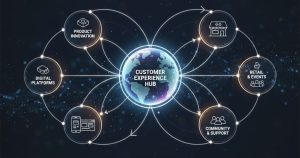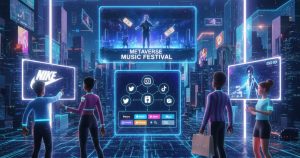Branding Strategy 2025: How to Build a Brand That Stands the Test of Time

And that is not far away in 2025, a year of new developments and challenges in branding. Whether you’re a fledgling newbie or a corporate giant, there are several key trends that will be key to your brand strategy in the years ahead – trends that reflect what consumers want, how technology will enable brands to interact with us and how culture will attempt to force brands to change.
Along with how to position your business, this blog will fill you in on all the key components of a successful branding strategy in 2025. From embracing technology to finding that authenticity, you’ll walk away with actionable advice to keep your brand meaningful, current and future-ready.
What is Branding in 2025?
It’s 2025, and branding isn’t quite how it used to be: a snazzy logo and a catchy catchphrase. It is about sharing experiences and connecting with your audience. It’s all about being real, creating messages that carry value, and use of the latest “engagement” tools to grab your target market by their heart strings.
This is what will dominate in the years ahead:
- Brand Truthfulness: Honesty and openness from brands is something consumers are valuing more.
- Personalization: Consumers respond positively to brands that know their individual preferences.
- Technology: With advancements such as AI and AR, technology is changing the way brands engage their audiences.
- Sustainable and Impact: Ethical trends in the fashion industry are a result of consumer demand for eco-friendly clothing that is also affordable.

Authenticity Trumps Perfection – Lean into Realness
Why it Matters in 2025:
Consumers are no longer wowed by the muzak and overly edited corporate speak. In this day and age, people are seeking real stories and brands that align with their values. 81% of buyers make purchase decisions based on trust according to an Edelman Trust Barometer study. To survive, brands need to keep it real — and relatable.
How to Enhance Authenticity:
- Humanize your brand by exhibiting behind-the-scenes content.
- Be honest about company practices, from sourcing to hiring.
- Own your mistakes. Owning the bad builds trust and shows that you are accountable.
Example:
All at once, Patagonia epitomizes “doing-real”: doing well enacting doing good. They are very transparent about their supply chain and sustainable initiatives and this is something that eco-friendly customers eat it up!
Leverage Technology to Create Immersive Brand Experiences
Why it Matters in 2025:
Consumer’s expectations are being transformed at an unprecedented pace by technological evolution. Advertisers who are using technology such as AI, AR, and blockchain can generate immersive and tailored experiences that can hold the attention of consumers.
How to Implement Technology:
- AI in Personalization: Utilize AI to analyze consumer data and provide personalized recommendations. Netflix, for one, is highly successful in its curation of content tailored to individual viewing habits.
- AR for Immersion: Add things like virtual try-ons or immersive product experiences. Consider IKEA’s AR app, which lets customers see how a piece of furniture looks in their home before they buy it.
- Blockchain for Transparency: Use blockchain to create trust with immutable proof of origin for your products.
Future Projections:
Analysts predict that in 5 years, more than 50% of eCommerce brands will use AR in some capacity. Begin experimenting with how these tools contribute to your brand strategy today, so you don’t get left behind.
Incorporate Personalization in Every Touchpoint
Why it Matters in 2025:
With the deluge of virtual noise, angmagtomas marketing didn’t cut it. This is where personalization comes into its own, allowing you to break through the noise and show that you really do know your customers.
Ways to Supercharge Personalization:
- Dynamically adjust content based on the user’s behaviors and interests.
- Utilize email sequences and targeted ads that can solicit contextual information from customers.
- Let customers co-create the experiences. For example, UGC campaigns can work wonders at helping to foster connections.
Example:
(Editor’s note: This is a master class in personalization.) Spotify converts data into a branding juggernaut by surfacing users’ listening behavior in a fun, shareable format.

Build a Purpose-Driven Brand
Why it Matters in 2025:
Serving discerning consumers of today is essential for companies that are rooted in ethics, inclusivity, and social responsibility. Recent years have seen a shift of 85 percent of consumers who redirect their purchases to more sustainable brands, according to the Global Sustainability Study 2021. Looking forward, these are going to further entrench.
How to Align Your Purpose with Action:
- Express your mission through your marketing.
- Reach out to nonprofits or organizations with values similar to your own.
- Support the use of sustainability in your operations, including carbon-neutral shipping and responsible packaging.
Example:
Toms dedication to social impact, such as Toms One for One program, has made it a purpose-driven brand that takes action to do good.
Foster Community Engagement
Why it Matters in 2025:
Successful brands form real relationships with their audiences. Active, interactive communities help make people fans for life, turning customers into brand advocates that promote you naturally.
Ways to Foster Engagement:
- Build private user groups or forums that will help your customers stay connected and share experiences.
- Create recurring live-streams, AMAs or events to engage directly with your audience on a frequent basis.
- Encourage participation with rewards programs or referral bonuses.
Example:
Glossier, however, puts its large network of beauty fans to work to start discussions and shill its wares. From brand love and meetups to social media engagement, the customer is the epicenter.
Cassandra 2.0: The Future of Branding Is in Hands Like Yours
Branding for the future in 2015 may be challenged to remain authentic to the values that bind a company together. Your credo should be authenticity, customization and mission. Through technology investment and deep immersive experiences, your brand has the potential to be part of that thing special to the customer, in a world where competing becomes more difficult.
You have now learned everything necessary, you are ready to equip your business with a future-focused branding plan. Don’t wait to innovate!






